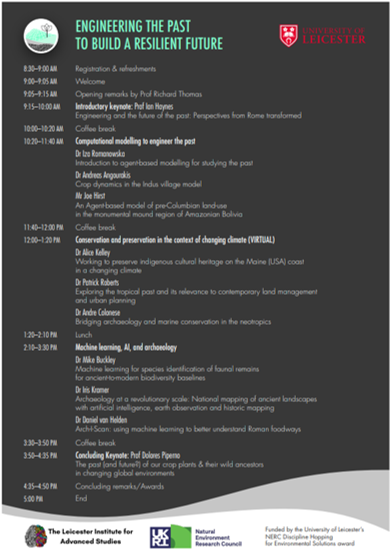I can scarcely believe it, but aspects of the before life that seemed irrevocably lost (or at least changed) are becoming possible again. Last Friday I attended my first in-person symposium in over two years (OK it was hybrid, but it counts!). While online conferences were convenient in their way (listening to presentations while doing the dishes is very efficient), they lacked the joy of human interaction. Yes, they were not nearly as bad as I anticipated and some new modes of interaction through chat functions were explored, but the value of random conversations over a coffee break could not be replicated online. Ultimately, while the presentations are what draws me to a particular conference, it is the contact with other researchers working on similar problems (or completely different ones!) that are the most valuable and lasting benefit of a conference. And, it turned out, very little had changed through Covid. It was an absolute joy.
The symposium, entitled Engineering the past to build a resilient future, sought to bring together archaeologists and engineers to address the need for interdisciplinary cooperation and discuss the ways in which principles from both disciplines can be integrated in order to better face the environmental catastrophes of our time.

The programme started with an inspiring keynote by Prof. Ian Haynes, who spoke about the Rome Transformed project. Through his discussion of that project, in which an interdisciplinary team investigates the changes in the Caelian quarter of Rome in the 1st to 8th centuries, he highlighted the importance of interdisciplinary communication. His suggested vocabulary of 3D reconstructions as provocations to spark discussions is going to see more use, since it was quoted repeatedly in the coffee breaks (I, for one, am definitely stealing it).
In the first session, computational modelling to engineer the past, contributors discussed the use of agent-based modelling in archaeology. Agent-based modelling has always intrigued me since it is basically a history simulator. By running little agents through time and/or space, we can investigate emergent patterns. Comparing these patterns to the ones found archaeologically allows us to explore which set of behaviour cues which we gave the agents approximates the archaeological patterns the best and could therefore suggest factors that could have been relevant in the past.
Session two was focussed on conservation. Both the conservation of archaeological sites under threat of climate change and development as well as species conservation were discussed. It was really interesting to see how archaeological research can intersect with and inform modern policy making, even in areas not immediately associated with archaeology (at least by me).
The last session was concerned with Machine Learning, which is where I could regale the audience with my antics. In the session we explored the different uses of Machine Learning for archaeology in making archaeological research more efficient and, by extension, more effective. By outsourcing some of the more mundane elements of the archaeological research process to the machine, we can speed it up and free up time from researchers for other aspects of the research. I described the efforts of the Arch-I-Scan project in our quest to better understand consumption of the past, but also posed the question of the impact that the energy consumption of training and tuning AI technology has on our world. This generated a very interesting discussion, even if it did earn me the title of most depressing speaker of the day.
Professor Dolores Piperno closed off the day with a brilliant keynote about the history and future of crop plants and their wild ancestors. Her reconstruction of how varying climatic conditions played a role in the domestication of maize and how such processes may impact crops in the impending climate disaster was fascinating, even if considering this future does not lead to happy thoughts.
The day was rounded off with discussion over refreshments and a dinner which, again, was a joy. Many thanks to Dr Himanshu Kaul, Dr Sarah Inskip and Dr Eric Guiry for organising the symposium and inviting me to present on our work. The opportunity to engage with others and exchange ideas across disciplinary boundaries is enormously rewarding, and greatly appreciated!
#EngThePast

 Subscribe to Daan van Helden's posts
Subscribe to Daan van Helden's posts
Lovely summary of the day; thanks, Daan!